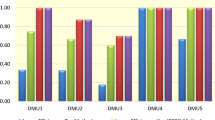Abstract
Measurement errors, incomplete information and noisy input and output data create difficulties in assessing the efficiency of data envelopment analysis (DEA). Previous studies have addressed uncertainty using interval analysis to extend the classical DEA problem to the case of bounded uncertainties. This paper proposes an approach to analyze the sensitivity and stability radius. By assuming that the data vary within a bounded interval, all of the decision making units (DMUs) can be classified as \(\hbox {E}^{++}, \hbox {E}^{+},\) and \(\hbox {E}^{-}\). To determine how sensitive these classifications are to possible data perturbations, the paper develops programs to calculate the stability radius within which the percentage data variation does not change the class of efficiency unit. In addition, the data changes are applied to not only the DMU that is being evaluation but also all of the DMUs and the various input and output subsets.
Similar content being viewed by others
References
Charnes, A., Cooper, W.W., Rhodes, E.: Measuring the efficiency of decision making units. Eur. J. Oper. Res. 2(6), 429–444 (1978)
Cook, W.D., Seiford, L.M.: Data envelopment analysis (DEA)-thirty years on. Eur. J. Oper. Res. 192(1), 1–17 (2009)
Liu, J.S., Lu, L.Y.Y., Lu, W.M., Lin, B.J.Y.: A survey of DEA applications. Omega 41(5), 893–902 (2013)
Wilson, P.W.: Detecting influential observations in data envelopment analysis. J. Prod. Anal. 6(1), 27–46 (1995)
Banker, R.D., Chang, H., Cooper, W.W.: Simulation studies of efficiency, returns to scale and misspecification with nonlinear functions in DEA. Ann. Oper. Res. 66(4), 233–253 (1996)
Neralic, L.: Sensitivity in data envelopment analysis for arbitrary perturbations of data. Glas. Mat. 32(2), 315–335 (1997)
Neralic, L.: Preservation of efficiency and inefficiency classification in data envelopment analysis. Math. Commun. 9(1), 51–62 (2004)
Charnes, A., Neralic, L.: Sensitivity analysis of the additive model in data envelopment analysis. Eur. J. Oper. Res. 48(3), 332–341 (1990)
Charnes, A., Neralic, L.: Sensitivity analysis of the proportionate change of inputs (or outputs) in data envelopment analysis. Glas. Mat. 27(47), 393–405 (1992)
Zhu, J.: Super-efficiency and DEA sensitivity analysis. Eur. J. Oper. Res. 129(2), 443–455 (2001)
Abri, A.G., Shoja, N., Jelodar, M.F.: Sensitivity and stability radius in data envelopment analysis. Int. J. Ind. Math. 3(1), 227–234 (2009)
Jahanshahloo, G.R., Hosseinzadeh, F., Shoja, N., Sanei, M., Tohidi, G.: Sensitivity and stability analysis in DEA. Appl. Math. Comput. 169, 897–904 (2005)
Jahanshahloo, G.R., Lotfi, F.H., Shoja, N., Abri, A.G., Jelodar, M.F., Firouzabadi, K.J.: Sensitivity analysis of inefficient units in data envelopment analysis. Math. Comput. Model. 53(5), 587–596 (2011)
Bruni, M.E., Conforti, D., Beraldi, P., Tundis, E.: Probabilistically constrained models for efficiency and dominance in DEA. Int. J. Prod. Econ. 117(1), 219–228 (2009)
Branda, M.: Diversification-consistent data envelopment analysis with general deviation measures. Eur. J. Oper. Res. 226(3), 626–635 (2013)
Wei, G., Chen, J., Wang, J.: Stochastic efficiency analysis with a reliability consideration. Omega 48, 1–19 (2014)
Cooper, W.W., Park, K.S., Yu, G.: IDEA and AR-IDEA: models for dealing with imprecise data in DEA. Manag. Sci. 45(4), 597–607 (1999)
Despotis, D.K., Smirlis, Y.G.: Data envelopment analysis with imprecise data. Eur. J. Oper. Res. 140(1), 24–36 (2002)
Entani, T., Maeda, Y., Tanaka, H.: Dual models of interval DEA and its extension to interval data. Eur. J. Oper. Res. 136(1), 32–45 (2002)
Esmaeili, M.: An Enhanced Russell Measure in DEA with interval data. Appl. Math. Comput. 219(4), 1589–1593 (2012)
Jahanshahloo, G.R., Matin, R.K., Vencheh, A.H.: On FDH efficiency analysis with interval data. Appl. Math. Comput. 159, 47–55 (2004)
Inuiguchi, M., Mizoshita, F.: Qualitative and quantitative data envelopment analysis with interval data. Ann. Oper. Res. 195(1), 189–220 (2012)
Wang, Y.M., Greatbanks, R., Yang, J.B.: Interval efficiency assessment using data envelopment analysis. Fuzzy Set. Syst. 153(3), 347–370 (2005)
Jahanshahloo, G.R., Lotfi, F.H., Malkhalifeh, M.R., Namin, M.A.: A generalized model for data envelopment analysis with interval data. Math. Comput. Model. 33(7), 3237–3244 (2009)
Yang, F., Ang, S., Xia, Q., Yang, C.C.: Ranking DMUs by using interval DEA cross efficiency matrix with acceptability analysis. Eur. J. Oper. Res. 223(2), 483–488 (2012)
Jahanshahloo, G.R., Lofti, F., Moradi, M.: Sensitivity and stability analysis in DEA with interval data. Appl. Math. Comput. 156(2), 463–477 (2004)
Charnes, A., Haag, S., Jaska, P., Semple, J.: Sensitivity of efficiency classifications in the additive model of data envelopment analysis. Int. J. Syst. Sci. 23(5), 789–798 (1992)
Charnes, A., Rousseau, J., Semple, J.: Sensitivity and stability of efficiency classifications in data envelopment analysis. J. Prod. Anal. 7(1), 5–18 (1996)
Andersen, P., Petersen, N.C.: A procedure for ranking efficient units in DEA. Manag. Sci. 39(10), 1261–1264 (1993)
Seiford, L.M., Zhu, J.: Sensitivity analysis of DEA models for simultaneous changes in all the data. J. Oper. Res. Soc. 49(10), 1060–1071 (1998b)
Seiford, L.M., Zhu, J.: Infeasibility of super-efficiency data envelopment analysis. INFOR 37(2), 174–187 (1999a)
Charnes, A., Cooper, W.W., Thrall, R.M.: A structure for classifying and characterizing efficiencies and inefficiencies in DEA. J. Prod. Anal. 2(3), 197–237 (1991)
Acknowledgments
We appreciate the support from Projects No. 71272160 and No. 71172011 of the National Natural Science Foundation of China, and the major Project No. KJW-A-1410 of strategic research of the Science and Technology Commission of Ministry of Education. This paper was completed as expected.
Author information
Authors and Affiliations
Corresponding author
Rights and permissions
About this article
Cite this article
He, F., Xu, X., Chen, R. et al. Sensitivity and stability analysis in DEA with bounded uncertainty. Optim Lett 10, 737–752 (2016). https://doi.org/10.1007/s11590-015-0895-2
Received:
Accepted:
Published:
Issue Date:
DOI: https://doi.org/10.1007/s11590-015-0895-2



